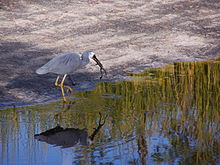Egretta
The breeding habitat of Egretta herons is marshy wetlands in warm regions.
They nest in colonies, often with other wading birds, usually on platforms of sticks in trees or shrubs.
These herons feed on insects, fish, and amphibians, caught normally by cautious stalking.
The genus Egretta was introduced in 1817 by the German naturalist Johann Reinhold Forster with the little egret as the type species.
[2][3] The genus name comes from the Provençal French for the little egret, aigrette, a diminutive of aigron, "heron".

